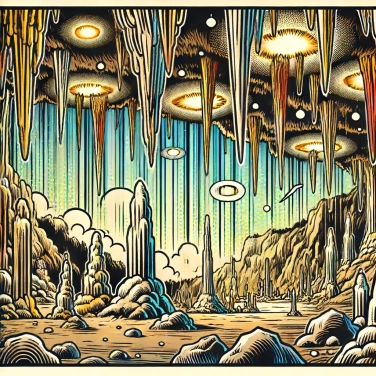Stalactites form on the ceiling of caves when mineral-laden water seeps in and deposits layers of calcite in droplets. Stalagmites, on the other hand, form on the cave floor from water droplets that fall and leave behind mineral deposits.

Caves generally form in limestone rocks due to the prolonged passage of groundwater. When this water passes through the soil, it absorbs carbon dioxide, forming a slightly acidic solution. This acidified water seeps down through cracks and faults, slowly dissolving the limestone and gradually carving out underground cavities. Bit by bit, these cavities enlarge until they sometimes become vast underground networks where stalactites and stalagmites may eventually appear.
It all starts with rainwater, loaded with carbon dioxide (CO₂) as it passes through the air and soil. This slightly acidic water seeps into limestone, a rock mainly composed of calcium carbonate. As it moves through the cracks, it gently attacks the limestone and dissolves some of the carbonate, creating a calcium-rich solution. When this water reaches the cave ceiling, it forms droplets. Upon contact with the air, a small portion of the carbon dioxide escapes, which reduces the acidity. The result: some of the dissolved carbonate precipitates and deposits tiny crystals of calcite. Drop by drop, these crystals accumulate and eventually form stalactites that hang quietly from the ceiling.
Stalagmites appear on the ground from the dissolved limestone carried by the drops of water falling from the ceiling. The drop falls, splashes on the ground, and then leaves behind a bit of calcite, that famous white or yellowish rock. Drop by drop, the layers of calcite slowly stack up. Over the years, or even thousands of years, this vertical accumulation will gradually form a stalagmite that grows upwards, somewhat like a tower of limestone rock. The more regular the flow of these droplets, the more harmonious and regular the stalagmite will take shape.
For stalactites and stalagmites to appear, it mainly requires high humidity, combined with regular precipitation. A relatively constant temperature also promotes their gradual growth, as strong variations can hinder the deposition of limestone. Slightly ventilated air helps by preventing the excessive accumulation of carbon dioxide, making it easier for dissolved limestone in the water to precipitate. Finally, the type of rock also plays a role: a limestone rich in calcium carbonate is ideal for the easy formation of mineral deposits.
Stalactites form on the ceilings of caves when water laden with limestone drips slowly and allows minerals to deposit gradually. In contrast, stalagmites appear on the ground directly below, thanks to droplets falling from the ceiling and splashing limestone. It's a true teamwork: the ceiling slowly builds its mineral peaks downward, while the ground responds by creating its own upward. Given enough time, a stalactite and a stalagmite can even join to form a beautiful column. These two structures thus tell the same geological story, but each tells it from its own perspective.
Some caves contain so-called 'eccentric' stalactites, which defy gravity by growing in unexpected directions. This is due to air currents and unusual crystallizations.
Limestone, a very common rock on our planet, is the ideal material for forming stalactites and stalagmites because it is easily dissolved by slightly acidic water, such as rainwater enriched with carbon dioxide.
Sometimes, stalactites and stalagmites can eventually join together after thousands of years to form a column that can reach impressive dimensions, like those found in Mammoth Cave in the United States.
By studying stalagmites, scientists can reconstruct the history of past climates over tens or even hundreds of thousands of years, thanks to their chemical composition and the layers that form regularly over time.
The limestone, the primary mineral component of these formations, naturally has a whitish or translucent color. However, various mineral impurities present in the infiltrated water can also produce a range of colors, from reddish to brown, including yellow and gray.
Sure! Here’s the translation: "Yes, although caves are their most common habitat, stalactites and stalagmites can also appear in tunnels, under certain man-made structures, or in abandoned mines or quarries, anywhere that mineral-rich water can slowly seep in and deposit its mineral load."
Yes, stalactites can sometimes break or fall due to earthquakes, accidental impacts, or the excessive weight they reach as they grow. That’s why, in some tourist caves, these natural formations are secured or regularly monitored.
The process is very slow: on average, stalactites and stalagmites grow by about a few millimeters to a few centimeters every hundred years. The precise rate depends on environmental conditions, including humidity, temperature, and the concentration of minerals in the water.
A stalactite is a rock formation that hangs down from the ceiling of a cave, formed by the dripping of limestone dissolved in water. In contrast, a stalagmite grows upward from the ground, formed by the deposits from drops that fall onto it. Sometimes, the two meet, forming a column.

No one has answered this quiz yet, be the first!' :-)
Question 1/5